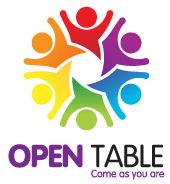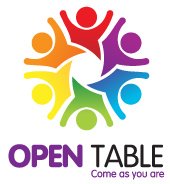What is biological sex?
Revd Jayne Taylor is a minister in the URC serving churches in Exeter. Before training for ministry she was a Research Scientist at the Babraham Research Campus in Cambridge. A brief list of her publications can be found at PubMed, a repository of research in the biological sciences. Search for ‘JA Taylor and Babraham’.
IN JULY 2023 the United Reformed Church (URC) governing body, General Assembly, voted in support of a resolution to recognise the inherent worth of people with diverse gender identities.
Revd Jayne Taylor, a member of the URC Equality Committee who supported the proposal, is also minister of the church which hosts the Open Table Exeter community, and a trustee of the Open Table Network.
Before ordination, Jayne was a a research scientist and biologist. She has written this essay to show that ‘biological sex’ is not as simple as it may seem.
What does the phrase ‘biological sex’ mean?
“Biological sex is a multi-faceted combination of chromosomes, genes, hormones, and anatomy.”
What may appear to be a simple question encompasses many components such as chromosomes, hormones, genitalia, and reproductive capacity. For most people, these are in alignment and so we could formulate a definition. But any simple definition could not include the rich diversity of human biology.
Chromosomes
For most people, their 46 chromosomes, arranged in 23 pairs, will include one pair which are either XY for males or XX for females. But for some people, this may not be the case. For example, some people have an extra chromosome such as XXY (Klinefelter syndrome), or XYY (Jacobs syndrome). Conversely, some people lack one of these chromosomes, with just one X chromosome present (Turner Syndrome). In addition, some people have XX/XY or X/XY mosaicism, where the cells in their body contain a mixture of both. Since people rarely have their chromosome makeup - their ‘karyotype’ - analysed, the number of people with atypical sex chromosomes may well be under-reported.
Hormones
Again, for most people the predominant sex hormones will be testosterone for males and oestrogen for females, though men also produce oestrogen, and women produce testosterone (the name for the various forms of testosterone is ‘androgens’) but it is the ratio of testosterone to oestrogen which varies for each sex. However, a range of factors can affect hormone levels. For example, Polycystic Ovary Syndrome (PCOS) affects around 10% of women in the UK. It is characterised by benign cysts in the ovaries which can lead to increased insulin resistance. The body increases production of insulin to overcome this which results in an increase in hormone production, including testosterone. Women with PCOS can have a doubling of their natural testosterone levels.
Genitalia
A health care professional, usually a midwife, assigns sex at birth by observing the genitals of a newborn baby. But sometimes this is not straightforward. In a review of babies receiving corrective surgery in the USA for ambiguous genitalia (neither clearly female nor male), researchers found that between 0.1 in 0.2% of live births were affected.[1] The reviewers estimated that the number of individuals who experience some form of variation in sex characteristics may be as high as 1 to 2%. In the UK population this may amount to more than one million people.
‘Intersex’ is an umbrella term used for differences in sex traits or reproductive anatomy. Intersex people are born with these differences or develop them in childhood. Many differences from the usual two ways human bodies develop are possible, in genitalia, hormones, internal anatomy, and chromosomes.[2]
Figure 1: Sexual differentiation.
Sex development in humans
In the first few weeks of life, embryos are neither male nor female. From around eight weeks gestation, foetuses with a Y chromosome and a gene called SRY (sex-determining region Y) begin to develop along the male pathway (see Fig. 1, left side)[3]. Testes then develop which begin to secrete testosterone, and the testosterone further masculinises the growing foetus.
Hormones are particularly influential in human development.[4] The actions of both testosterone and oestrogen at sensitive periods during pregnancy can have a marked effect on the sex of a baby. For example, a foetus with XY chromosomes can develop Complete Androgen Insensitivity Syndrome (CAIS). Testes form but the body does not respond to the testosterone they secrete, so it is partly converted into oestrogen. A baby born with this condition may have a vagina, and be assigned female at birth. Usually, when approaching teenage years and in the absence of puberty, the girl may visit her GP to discover internal testes are present. These are often removed because of the potential risk of becoming cancerous. This means the girl will require Hormone Replacement Therapy (HRT) indefinitely.
A similar XY condition is Swyer Syndrome. This is characterised by lower testosterone levels and individuals may have internal, as well as external female anatomy, in some cases with the potential to give birth.[5]
Conversely, there is a condition called Congenital Adrenal Hyperplasia (CAH), where the adrenal glands, above the kidneys, are enlarged. This can occur whatever chromosomes are present, but if the individual has XX chromosomes, they may have ambiguous or male genitals at birth.
Is there a link between people who are intersex and people who are transgender?
Traditionally, medical science has considered people who are intersex to have a variation of their physiology, and people who are transgender to have a variation of their psychology. This is a simplistic view. For example, surveys of people who have an intersex variation have shown that 20-30% also experience gender dysphoria.[6] Furthermore, UK law does not permit any intersex individual to change their sex classification, even in cases where their assigned sex is the result of surgery, except by declaring that they are transgender, including a diagnosis of gender dysphoria.
There is also scientific research which demonstrates that there are biological factors involved in transgender identity. Studies have found that transgender individuals may have brain structures that more closely resemble those of their identified gender rather than their assigned sex.[7] Another study published in the journal Nature Communications found that transgender individuals have genetic variations that are associated with their gender identity.[8] A review of research on the biological basis of transgender identity published in the journal Endocrine Reviews concluded that there is evidence to suggest that transgender identity has a biological basis, involving a complex interplay of genetic, hormonal, and environmental factors.[9]
The Endocrine Society is a leading professional, international medical organization in the field of endocrinology, the study of hormones. In 2020 they issued a Position Statement[10] and concluded:
Considerable scientific evidence has emerged demonstrating a durable biological element underlying gender identity.
Attempts to change gender identity in intersex patients to match external genitalia or chromosomes are typically unsuccessful.
Identical twins are more likely to both experience transgender identity as compared to non-identical twins, implying a genetic basis.
For individuals with female chromosomes (XX), rates of male gender identity are higher for those exposed to higher levels of androgens in utero.
Individuals with XY chromosomes and Complete Androgen Insensitivity Syndrome are more likely to identify as transgender women.
Certain brain scan patterns are more likely to be associated with gender identity rather than external genitalia or chromosomes.
Conclusion
Biological sex is a multi-faceted combination of chromosomes, genes, hormones, and anatomy. For most people, these combine to form one of two sexes. But for some people, whether intersex or transgender, one or more of these characteristics is not in alignment and sex is far more nuanced. A simple either/or binary model is overly simplistic.[11]
Some questions to ponder
For people born as intersex, should surgery be used to make sure that they conform to one or other sex?
In the light of this article, would it be possible to define the words ‘woman’ or ‘man’ in a way which would include the diversity of human existence?
Would your view of people who are transgender differ based on the evidence that it is a product of biology and not a choice or lifestyle?
Footnotes
[1] Blackless, M. et al. (2000). How sexually dimorphic are we? Review and synthesis. American Journal of Human Biology, 12(2), 151-166.
[2] https://interactadvocates.org/faq/#definition
[3] Sexual differentiation. The human embryo has indifferent sex accessory ducts until the seventh week of development. Original work, adapted from figure 17.4 of the following source: Gilbert SF. Developmental biology, sixth edition. Sunderland, MA: Sinauer Associates, 2000. Jonathan.Marcus licensed under the Creative Commons Attribution-Share Alike 3.0 Unported license
[4] Bakker, J. (2021) J. Neuroendocrinology 34:e13050. https://doi.org/10.1111/jne.13050
[5] Winkler, I. et al. (2022) A Successful New Case of Twin Pregnancy in a Patient with Swyer Syndrome—An Up-to-Date Review on the Incidence and Outcome of Twin/Multiple Gestations in the Pure 46,XY Gonadal Dysgenesis. Int. J. Environ. Res. Public Health
[6] Intersex Society of North America (ISNA) (2008) Intersex and Gender Identity www.isna.org/faq/gender_identity
[7] Zhou, J. N. et al. (1995). A sex difference in the human brain and its relation to transsexuality. Nature, 378(6552), 68-70.
[8] Stroud LR, et al. Genetic and environmental influences on transgender identity: a study of twins. Nature Communications. 2019;10: 2294.
[9] Gooren LJ, et al. The biology of human psychosexual differentiation. Endocrine Reviews. 2006;27(1): 101-132.
[10] The Endocrine Society (2020) https://www.endocrine.org/advocacy/position-statements/transgender-health
[11] Ainsworth, C. (2015) The idea of two sexes is simplistic. Biologists now think there is a wider spectrum than that. Nature 518:288–291



